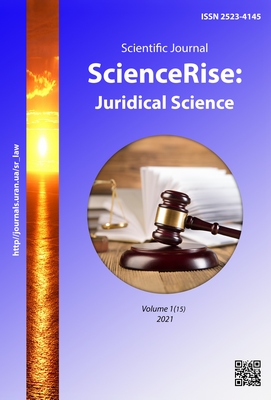Analysis of legal principles of life safety
DOI:
https://doi.org/10.15587/2523-4153.2021.228246Keywords:
concepts and categories of life safety, directions of life safety at the enterprise, basics of life safety managementAbstract
This study discusses the legal framework for life safety in Ukraine as of the current year. Ensuring an adequate level of safety at the enterprises of various forms of ownership and directions of the modern economy is a vital task in terms of creating decent working conditions in the country and the development of its economy. The development of the sovereign Ukraine must be accompanied by the creation of a safe state of the environment, economic production, and living conditions to ensure the proper level of human life. The main place in this process is occupied by the legislation in the field of regulation of relations between human health and the environment and safety in emergencies and situations of everyday life, i.e. life safety. The relevance of the subject is conditioned by the need to create an appropriate legal framework for life safety in the country as of its current state. The methodology of this study is based on a combination of a systematic approach to determining the main factors that ensure the establishment of legal foundations for life safety in Ukraine at present and an analytical method of research on a wide scope of issues in this subject area. The main results, obtained during this study, include the identification of the main factors of life safety in modern Ukrainian society and the importance of the legal framework, developed by the state for proper regulation of these issues, as well as the main directions of development of a certain level of life safety culture in modern Ukrainian society. Prospects for further research within the framework of the chosen subject area are conditioned by the need to qualitatively identify the main factors, influencing the process of gradual development of the legal framework for life safety in Ukraine as of its current state and the importance of timely coverage of relevant legal aspects that are vital in modern realities. The applied value of this study lies in the possibility of implementing its main results and conclusions in practice in order to obtain a reliable tool for timely and high-quality determination of the basic legal principles of life safety in Ukraine
References
- Patwa, T. Z., Moussa, M. (2018). Transforming your culture of safety: Time to lead. Society of Petroleum Engineers – SPE International Conference and Exhibition on Health, Safety, Security, Environment, and Social Responsibility 2018. Richardson: Society of Petroleum Engineers, 1–8. doi: http://doi.org/10.2118/190671-ms
- Hill, R. H. (2018). Make safety a habit! Journal of Chemical Health and Safety, 25 (2), 12–17. doi: https://doi.org/10.1016/j.jchas.2017.10.006
- Dastafkan, R., Salehi, H., Hooshmand, M. M. (2020). Provision of Peace and Right to Health through Sanctions: Threats and Opportunities. Archives of Iranian Medicine, 23 (4Suppl1), S43–S48. doi: http://doi.org/10.34172/aim.2020.s9
- Bereziuk, O. V., Lemeshev, M. S. (2011). Bezpeka zhyttiediialnosti. Vinnytsia: VNTU, 204.
- Devisilov, V. A., Pavlikhin, G. P. (2009). Kompetentsii po bezopasnosti zhiznedeiatelnosti v standartakh vysshego obrazovaniia. Vysshee obrazovanie v Rossii, 7, 179–180.
- Miller, T. R., Levy, D. T., Swedler, D. I. (2018). Lives saved by laws and regulations that resulted from the Bloomberg road safety program. Accident Analysis & Prevention, 113, 131–136. doi: http://doi.org/10.1016/j.aap.2018.01.014
- Jones Rn, A. (2018). Safety: Practice of caring for the welfare of others. Journal of Perioperative Practice, 28 (7-8), 171. doi: http://doi.org/10.1177/1750458918785763
- Vaulin, V. I. (2019). Teoreticheskie osnovy podgotovki studentov v oblasti bezopasnosti zhiznedeiatelnosti. Izvestiia Saratovskogo universiteta. Seriia: Filosofiia. Psikhologiia. Pedagogika, 2 (19), 141–144.
- Bosak, V. N. (2017). Bezpeka zhyttiediialnosti liudyny: Osoblyvosti vykladannia ta metodychne zabezpechennia. Vyshcha tekhnichna osvita, 1 (1), 40–45.
- Timoshkov, V. F. (2018). Paradigma bezopasnosti zhiznedeiatelnosti. Nauka i obrazovanie segodnia, 2, 171–172.
- Nadein, K. A. 2016. Metody i sredstva formirovaniia kultury bezopasnosti zhiznedeiatelnosti. Psikhologiia i pedagogika: Metodika i problemy prakticheskogo primeneniia, 5, 129–133.
- Pro tsyvilnu oboronu Ukrainy (1993). Zakon Ukrainy No. 555-X1U. 03.02.1993. Available at: https://zakon.rada.gov.ua/laws/show/2974-12#Text
- Pro pozhezhnu bezpeku (1993). Zakon Ukrainy No. 3745-XII. 17.12.1993. Available at: https://zakon.rada.gov.ua/laws/show/3745-12#Text
- Pro dorozhnii rukh (1993). Zakon Ukrainy No. 3353-XII. 30.06.1993. Available at: https://zakon.rada.gov.ua/laws/show/3353-12#Text
- Pro zakhyst liudyny vid vplyvu ionizuiuchykh vyprominiuvan (1998). Zakon Ukrainy No. 15/98-ВР. 19.02.1998. Available at: http://parusconsultant.com/?doc=005ZWDFA7F
- Zarubina, R. V. (2010). Formirovanie kultury bezopasnosti. Vestnik Taganrogskogo instituta im. A. P. Chekhova, 2, 240–245.
Downloads
Published
How to Cite
Issue
Section
License
Copyright (c) 2021 Федор Васильевич Апшай, Олег Васильевич Халак

This work is licensed under a Creative Commons Attribution 4.0 International License.
Our journal abides by the Creative Commons CC BY copyright rights and permissions for open access journals.
Authors, who are published in this journal, agree to the following conditions:
1. The authors reserve the right to authorship of the work and pass the first publication right of this work to the journal under the terms of a Creative Commons CC BY, which allows others to freely distribute the published research with the obligatory reference to the authors of the original work and the first publication of the work in this journal.
2. The authors have the right to conclude separate supplement agreements that relate to non-exclusive work distribution in the form in which it has been published by the journal (for example, to upload the work to the online storage of the journal or publish it as part of a monograph), provided that the reference to the first publication of the work in this journal is included.









